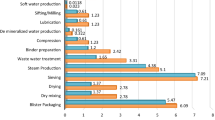Abstract
Background, Goal and Scope
The research presented here represents one part of GlaxoSmithKline’s (GSK) efforts to identify and improve the life cycle impact profile of pharmaceutical products. The main goal of this work was to identify and analyze the cradle-to-gate environmental impacts in the synthesis of a typical Active Pharmaceutical Ingredient (API). A cradle-to-gate life cycle assessment of a commercial pharmaceutical product is presented as a case study.
Methods
Life cycle inventory data were obtained using a modular gate-to-gate methodology developed in partnership with North Carolina State University (NCSU) while the impact assessment was performed utilizing GSK’s sustainability metrics methodology.
Results and Discussion
Major contributors to the environmental footprint of a typical pharmaceutical product were identified. The results of this study indicate that solvent use accounts for a majority of the potential cradle-to-gate impacts associated with the manufacture of the commercial pharmaceutical product under study. If spent solvent is incinerated instead of recovered the life-cycle profile and impacts are considerably increased.
Conclusions
This case study provided GSK with key insights into the life-cycle impacts of pharmaceutical products. It also helped to establish a well-documented approach to using life cycle within GSK and fostered the development of a practical methodology that is applicable to strategic decision making, internal business processes and other processes and tools.
Similar content being viewed by others
References
EMPA (1996): ECOPRO Life Cycle Assessment software. St. Gallen, Switzerland, EMPA (Swiss Federal Laboratories for Material Testing and Research)
PIRA (1998): PEMS Life Cycle Assessment software. Surrey, UK, Pira International
Pré Consultants (1998): SIMAPRO Life Cycle Assessment software. Amesfoort, The Netherlands. Pré Consultants BV
Curzons AD, Constable DJC, Cunningham VL (1999): Solvent Selection Guide: A Guide to the Integration of Environmental, Health and Safety Criteria into the Selection of Solvents. Clean Products and Processes 1, 82–90
Jiménez-González C, Curzons AD, Constable DJC, Cunningham VL(2003): Expanding GSK’s Solvent Selection Guide — Application of Life Cycle Assessment to Enhance Solvent Selections. Manuscript submitted to the Journal of Clean Technologies and Environmental Policy
Jiménez-González C (2000): Life Cycle Assessment in Pharmaceutical Applications. Ph.D. Thesis, North Carolina State University, 257 pp
Constable DJC, Curzons AD, Cunningham VL (2002): Metrics to ‘green’ chemistry — Which are the best? Green Chemistry 4, 521–527
Jiménez-González C, Kim S, Overcash MR (2000): Methodology of Developing Gate-to-Gate Life Cycle Analysis Information. Int JLCA 5 (3) 153–159
Reid RC, Prausnitz JM, Poling BE (1987): The Properties of Gases and Liquids, 4th Ed., McGraw Hill, New York, 741 pp
Jiménez-González C, Overcash MR (2000): Energy sub-modules applied in life cycle inventory of processes. J Clean Products and Processes 2, 57–66
Dumas RD (1997): Energy usage and emissions associated with electric energy consumption as part of a solid waste management life cycle inventory model. Department of Civil Engineering, North Carolina State University, Raleigh NC
US Department of Commerce, Economics and Statistics Administration, US Census Bureau, US Department of Transportation, Bureau of Transportation Statistics (1999): 1997 Economic Census, Transportation. 1997 Commodity Flow Survey (Issued in 1999), EC97TFC-US
Jiménez-González C, Overcash MR, Curzons AD (2001): Treatment Modules — A partial Life Cycle Inventory. J Chemical Technology and Biotechnology 76, 707–716
Camobreco V, Ham R, Barlaz, M, Repa E, Felker M, Rousseau C, Rathle J (1999): Life-cycle inventory of a modern municipal solid waste landfill. Waste Manage Res 17, 394–408
International Organization of Standardization (1997): ISO 14040 — Environmental management — Life cycle assessment — Principles and framework, Geneva, Switzerland, 12 pp
International Organization of Standardization (1998): ISO 14041 — Environmental management — Life cycle assessment — Goal and scope definition and inventory analysis. Geneva, Switzerland, 22 pp
Constable DJC, Curzons AD, Freitas Dos Santos LM, Green GR, Hannah RE, Hayler JD, Kitteringham J, McGuire MA, Richardson JE, Smith P, Webb L, Yu M (2001): Green Chemistry Measures for process research and development. Green Chemistry 3, 7–9
Curzons AD, Constable DJC, Mortimer DN, Cunningham VL (2001): So you think your process is green, how do you know? Green Chemistry 3, 1–6
Author information
Authors and Affiliations
Corresponding author
Rights and permissions
About this article
Cite this article
Jiménez-González, C., Curzons, A.D., Constable, D.J.C. et al. Cradle-to-gate life cycle inventory and assessment of pharmaceutical compounds. Int J LCA 9, 114–121 (2004). https://doi.org/10.1007/BF02978570
Received:
Accepted:
Issue Date:
DOI: https://doi.org/10.1007/BF02978570




